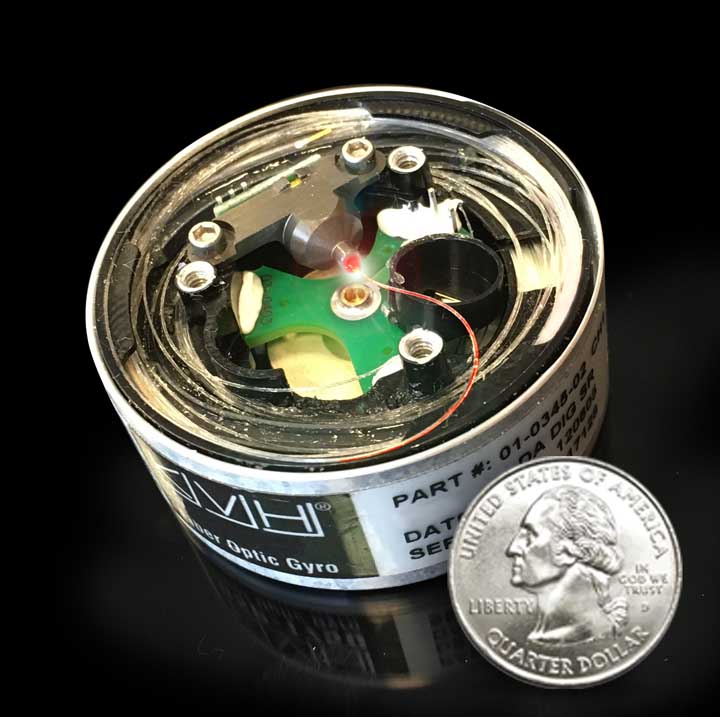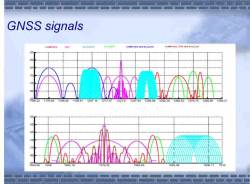 In this photo, the red illumination represents light moving through the FOG’s optical circuit of coiled fiber; this circuit is the FOG’s sensing unit and can be mounted with power and processing electronics within a driverless car to provide precise data for the car’s navigation systems. KVH photo
In this photo, the red illumination represents light moving through the FOG’s optical circuit of coiled fiber; this circuit is the FOG’s sensing unit and can be mounted with power and processing electronics within a driverless car to provide precise data for the car’s navigation systems. KVH photoKVH Industries, Inc., says that it is developing a fiber optic gyro (FOG)–based, low-cost inertial sensor for self-driving cars, based on its successes in autonomous vehicle prototype programs and a wide range of unmanned applications.
The Middletown, Rhode Island–based company also announced that it has introduced a developer’s kit to support integration and testing of FOG-based inertial measurement units (IMUs) for driverless cars.
KVH Industries, Inc., says that it is developing a fiber optic gyro (FOG)–based, low-cost inertial sensor for self-driving cars, based on its successes in autonomous vehicle prototype programs and a wide range of unmanned applications.
The Middletown, Rhode Island–based company also announced that it has introduced a developer’s kit to support integration and testing of FOG-based inertial measurement units (IMUs) for driverless cars.
Driverless cars represent one of the fastest areas of autonomous-systems development. In announcing early this year that an updated policy concerning automated vehicles will soon be published, the National Highway Traffic Safety Administration, which is part of the U.S. Department of Transportation, noted, “The rapid development of emerging automation technologies means that partially and fully automated vehicles are nearing the point at which widespread deployment is feasible.”
“Extremely precise heading based on fiber optic gyro technology is absolutely essential for autonomous vehicle performance,” says Martin Kits van Heyningen, KVH’s chief executive officer. “This is something we learned from having been involved with more than a dozen driverless car development programs over the years.”
For example, FOGs provide precise azimuth measurements that an autonomous car’s logic processing unit and control systems can use to determine motion through a curve. An IMU — which may include FOGs and accelerometers in a single compact package — can provide accurate six-degrees-of-freedom angular rate and acceleration data to precisely track the position and orientation of the car even when GPS is unavailable.
“We have successfully produced more than 90,000 fiber optic gyros for an extensive range of unmanned applications, in part because of our ability to tailor size, performance, and cost to meet different design needs,” says Jeff Brunner, KVH’s vice president for FOG operations, an experience that he says will enable KVH to produce a low-cost sensor when driverless cars enter full-scale production.
KVH says its FOGs and FOG-based IMUs are used in prototype programs not only for autonomous cars, but also for production programs for underwater unmanned vehicle navigation and rail/track geometry measurement systems, and have been adopted for commercial applications such as land-based street mapping platforms, unmanned aerial systems, camera stabilization systems, and remotely operated subsea systems.
According to the company, its 1750 IMU was incorporated into 11 of the 23 humanoid robot finalists in last year’s DARPA Robotics finals, a competition designed to showcase robots capable of intervening for and even replacing humans in high-risk situations such as fires, earthquakes, and other natural disasters.
The new developer’s kit includes the user interface software and all components needed to immediately connect a KVH FOG or FOG-based IMU to a computer in order to configure, analyze, and test the unit.
“The kit is designed to help engineers get up and running in minutes, making it easier to run diagnostics and accelerate their system development,” says Roger Ward, KVH’s director of FOG product development.





